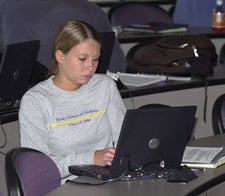Students, professors benefit from new classroom tools
Out with the dingy orange-and-gold seats, in with high-tech seating complete with receptacles for charging laptop computers.
Out with overheads, in with computerized presentation tools that put PowerPoint to shame.
When first-year medical students arrived for class at the Brody School of Medicine at East Carolina University this year, their “homeroom,” Brody Medical Sciences Building Room 2N-86, had been remodeled. It is now a “SMART” (Shared Multimedia Access to Resources for Teaching) classroom.

Second-year medical student Renee Carroll has her laptop plugged in while studying in one of the new SMART Classrooms at the Brody Medical Sciences Building. Photo by Cliff Hollis
Brody 2S-04, the primary classroom for second-year medical students, has also been renovated to include seating with electrical outlets, new carpet, a fresh coat of paint, new lights, acoustical ceiling panels, multimedia lecterns and plasma display screens.
The new SMART classrooms offer the latest instructional technologies and applications, said Susan Thornton, computing consultant with Information Technology and Computing Services and former chairman of the SMART Classroom Technology Steering Committee for the university. In addition to wireless Internet access in the room, the classrooms also offer instructors the ability to use their laptop computers as the primary teaching tool. Students can view an image from their instructor’s laptop displayed on the SMART Technologies Sympodium interactive lectern.
Thornton gets excited talking about the features of the Sympodium. It allows an instructor to use a stylus to navigate the display and options. The instructor can draw and teach through the computer. It’s like an old overhead projector but 10 times better, Thornton said.
“These classrooms haven’t been renovated really in 20 years, so they needed a facelift,” Thornton said. “And since the medical school implemented the laptop initiative the problem was there was no power at the individual seats. That’s one of the reasons I felt like we needed to update to accommodate this new technology.”
New medical students bring a laptop computer when they arrive for their first week of medical school.
The renovation was completed for about $300,000, using some money from the $3.1 billion higher education bond referendum in 2000.
“We believe it’s important to offer students an exciting learning environment and provide ECU faculty a variety of different teaching options,” Thornton said. “As a supplement to traditional classrooms, enhanced classrooms create a collaborative setting that can stimulate instructors and encourage greater student participation, leading to improved learning.”
The special classrooms aren’t limited to the medical campus. The Austin Building on ECU’s east campus will have four SMART classrooms, and the new Science and Technology Building will have many SMART classrooms, Thornton said.